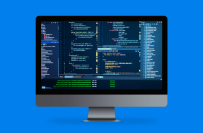
AI-Powered Facial Biometrics for Identity Verification
$5000-10000 USD
Fechado
Publicado há 16 dias
$5000-10000 USD
Pago na entrega
App Development Overview
Will be a state-of-the-art identity verification platform designed for businesses that require advanced security measures for authenticating users. The core goal is to provide continuous, AI-driven identity monitoring with a comprehensive risk management system that helps prevent fraud in real-time, ensuring the safety and integrity of users' personal data.
Core Features
Context-Aware Multi-Factor Verification:
The app must support multiple layers of authentication, including password, biometric (fingerprint, face recognition), and One-Time Passwords (OTPs).
It will dynamically adjust the level of verification required based on the user's context (e.g., location, device used, time of day, type of transaction).
Example: If a user logs in from a new device or unusual location, additional verification (like facial recognition or OTP) will be required.
The system should integrate location-based services and device fingerprinting to assess the context of each session.
AI-Driven Dynamic Identity Risk Scoring:
The platform will utilize AI algorithms to assign a dynamic risk score to every user based on their profile and behaviors.
Factors like the user’s historical behavior (e.g., login patterns, transaction volume), device type, and geolocation will influence the risk score.
The system will use machine learning models to constantly update the risk score in real-time, adjusting the threshold for required actions (e.g., blocking, alerting, or requiring additional verification) based on the user’s behavior.
The AI model will continuously learn from new data to refine its risk assessments and improve accuracy over time.
AI-Powered Continuous Identity Monitoring:
The app will not only verify users during onboarding but will also continuously monitor users’ activities throughout their entire lifecycle.
Continuous tracking will include:
Behavioral biometrics: Analyzing how users interact with the app (e.g., typing speed, mouse movements, touch gestures on mobile devices).
Transaction patterns: Tracking financial transactions, purchases, and service access to detect abnormal activity.
Device fingerprinting: Monitoring the devices used to access the platform, ensuring they match known profiles and flagging any changes.
The system will use real-time data enrichment by pulling information from external sources like social media accounts, device metadata, and dark web intelligence to check for potential identity compromises or fraud.
Adaptive Risk Management System:
Based on the dynamic risk scoring and continuous monitoring, the platform will offer adaptive risk management that automatically adjusts the security measures for each user.
Risk thresholds will be customizable: Higher-risk users can be required to undergo more stringent verification methods.
The platform will be able to automatically trigger additional verification actions (e.g., biometric re-authentication, OTP, security questions) when suspicious activity is detected.
Alerts and notifications will be sent to businesses in real-time, allowing them to take immediate actions (e.g., blocking suspicious accounts or flagging them for manual review).
Fraud Detection and Anomaly Alerts:
The platform will use AI algorithms to detect anomalous behaviors or signs of fraud.
It will analyze patterns such as unusual login locations, multiple failed authentication attempts, or transactions that deviate from the user’s normal behavior.
Automated alerts will notify businesses of potential fraud, allowing them to act immediately before any damage occurs.
Comprehensive User Dashboard:
Businesses will have access to a centralized dashboard that allows them to:
View detailed risk profiles for each user, including historical risk scores, actions taken, and ongoing monitoring results.
See real-time alerts and notifications about suspicious activities and fraud attempts.
Configure the adaptive risk thresholds and adjust verification requirements as needed.
Access detailed analytics on the effectiveness of the fraud detection system.
Scalable & Secure Architecture:
The system must be built with a scalable, cloud-based architecture to support millions of users and high volumes of data processing.
It must ensure end-to-end encryption and data privacy compliance (e.g., GDPR, CCPA) for sensitive user data, such as biometric information and financial transaction data.
The platform must be designed to handle high levels of concurrent requests without affecting performance, ensuring a seamless experience for users.
Development Requirements
Tech Stack:
Frontend: React or Angular for responsive and dynamic user interfaces.
Backend: Node.js or Python for API development and handling large-scale user data processing.
Database: MongoDB or PostgreSQL for secure and scalable data storage.
AI & Machine Learning: TensorFlow, PyTorch, or Scikit-learn for developing AI algorithms and models for risk scoring, fraud detection, and behavioral analysis.
Biometric Verification: Integration with platforms like Face++, Microsoft Azure Cognitive Services, or AWS Rekognition for face recognition and other biometric authentication methods.
Mobile App: React Native or Flutter for cross-platform mobile applications.
Cloud Infrastructure: AWS, Google Cloud, or Microsoft Azure for scalability, data security, and compute power.
Key Integrations:
Payment Gateway: Integration with popular payment processors (Stripe, PayPal, etc.) for businesses that need fraud detection in financial transactions.
Geolocation Services: Use IP-based geolocation and GPS data to assess the user's physical location during login and transactions.
Two-Factor Authentication (2FA): Integration with services like Twilio, Authy, or Google Authenticator for generating one-time passcodes (OTPs).
External Threat Intelligence: Integration with services like Have I Been Pwned and Dark Web Intelligence Providers to detect compromised identities.
Security and Compliance:
All data related to identity verification, biometrics, and sensitive transactions should be encrypted using AES-256 and stored securely.
The app must comply with global regulations, such as GDPR, CCPA, and SOC 2 standards, especially when handling personal data or payment details.
Implement secure authentication protocols like OAuth 2.0 or JWT for API access control and session management.
Real-Time Data Processing:
Use streaming technologies (e.g., Apache Kafka or AWS Kinesis) for real-time data processing to monitor user behavior and detect fraud continuously.
Implement event-driven architecture to trigger actions based on real-time user behavior and risk levels.
Timeline for Development:
Phase 1: Planning & Architecture
Define requirements, user stories, and detailed specifications.
Choose the technology stack, finalize system architecture, and plan for scalability and security.
Phase 2: Core Development & AI Model Training
Develop the backend, frontend, and database architecture.
Implement AI-driven risk scoring models and continuous monitoring systems.
Integrate biometric authentication methods and multi-factor verification.
Implement security measures and regulatory compliance checks.
Phase 3: Integration & Testing
Integrate payment gateways, geolocation services, and threat intelligence APIs.
Thorough testing of AI models, fraud detection algorithms, and user behavior analysis.
User acceptance testing (UAT) to validate all features and workflows.
Phase 4: Launch & Post-Launch Support (Ongoing):
Deploy the platform on cloud infrastructure (AWS, Azure, or Google Cloud).
Ongoing maintenance, bug fixing, and optimization based on user feedback.
Continuous improvement of AI models and fraud detection systems.
The system must be HIPAA, AES-256 compliant.
ID do Projeto: 38887005
Sobre o projeto
76 propostas
Projeto remoto
Ativo há 10 dias
Quer ganhar algum dinheiro?
Benefícios de ofertar no Freelancer
Defina seu orçamento e seu prazo
Seja pago pelo seu trabalho
Descreva sua proposta
É grátis para se inscrever e fazer ofertas em trabalhos
76 freelancers estão ofertando em média $8.738 USD for esse trabalho

5,0
(199 avaliações)
8,0
8,0

5,0
(117 avaliações)
6,4
6,4

4,9
(8 avaliações)
5,8
5,8

5,0
(22 avaliações)
5,6
5,6

4,3
(20 avaliações)
5,4
5,4

5,0
(6 avaliações)
4,7
4,7

5,0
(6 avaliações)
4,6
4,6

5,0
(1 avaliação)
4,4
4,4

5,0
(4 avaliações)
4,2
4,2

4,2
(2 avaliações)
5,1
5,1

4,4
(1 avaliação)
4,3
4,3

4,8
(8 avaliações)
3,8
3,8

4,8
(1 avaliação)
2,8
2,8

5,0
(1 avaliação)
1,7
1,7

0,0
(0 avaliações)
0,0
0,0

0,0
(0 avaliações)
0,0
0,0

0,0
(0 avaliações)
0,0
0,0

0,0
(0 avaliações)
0,0
0,0

0,0
(0 avaliações)
0,0
0,0

0,0
(0 avaliações)
0,0
0,0
Sobre o cliente

Eldon, United States
0,0
0
Método de pagamento verificado
Membro desde out. 17, 2020
Verificação do Cliente
Outros trabalhos deste cliente
$750-1500 USD
$1500-3000 USD
$1500-3000 USD
$5000-10000 USD
$1500-3000 USD
Trabalhos semelhantes
$10000-12000 USD
$15-25 USD / hora
$10-30 USD
$2-8 USD / hora
$250-750 USD
$30-250 USD
₹1500-12500 INR
$30-250 USD
₹1500-3500 INR
₹1500-12500 INR
$30-250 CAD
$30-250 USD
$30-250 USD
$200-600 USD
₹1500-12500 INR
₹1500-12500 INR
$10-30 USD
₹37500-75000 INR
$30-200 USD
$25-50 CAD / hora
Obrigado! Te enviamos um link por e-mail para que você possa reivindicar seu crédito gratuito.
Algo deu errado ao enviar seu e-mail. Por favor, tente novamente.
Carregando pré-visualização
Permissão concedida para Geolocalização.
Sua sessão expirou e você foi desconectado. Por favor, faça login novamente.






















